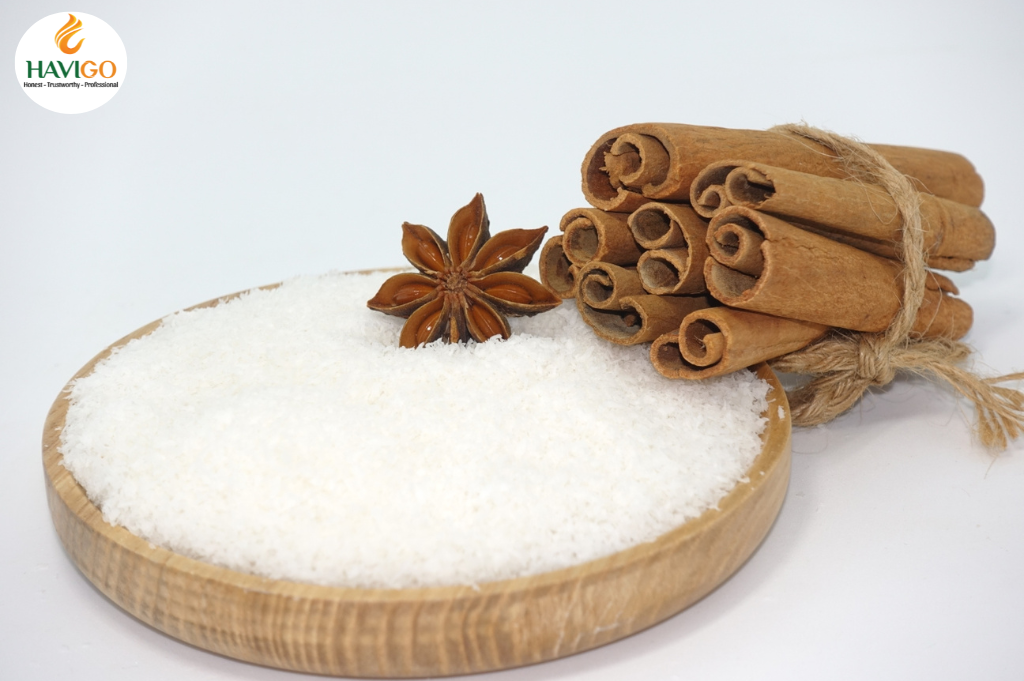How producers make coconuts into desiccated coconut is a fascinating process. In this post, we will discover the processing of harvesting, and how producers control the moisture content of desiccated coconut to make high-quality desiccated coconut products.
1. Processing & Moisture content of Desiccated Coconut
It all starts with the harvesting of mature coconuts. Once harvested, producers husk and shell the coconuts to reveal the white meat. Then, they shred this meat of coconut into various sizes, such as fine, medium, chips and flake.

The drying process is crucial to producing high-quality desiccated coconut. This step helps to remove moisture content and preserve the desiccated coconut. There are various drying methods, in which the below are the most popular:
Oven drying: Producers place shredded coconut in ovens at a temperature of around 50-60°C for several hours. This method offers precise control over the drying process.
Air drying: A more traditional method, they spread the shredded coconut on trays and allow it to dry naturally. This process is slower but often results in a product with a more natural flavor.
Mechanical drying: They use specialized drying machines to efficiently remove moisture. This method is faster and more consistent than traditional methods.
After the drying process, desiccated coconut reaches its ideal moisture. However, the moisture of desiccated coconut is based on its fat content. Low-fat desiccated coconut is at 3% moisture, while high-fat one is at 5%.
Once coconut is dried, it undergoes a grading process to ensure quality and consistency. Then, producers carefully pack desiccated coconut in airtight containers to maintain its flavor and prevent spoilage. By following these steps, manufacturers can produce high-quality, delicious, and long-lasting desiccated coconut.
2. All about Fine Grade Desiccated Coconut
When we compare to medium grades, the fine grade boasts a finer size. Fine coconut boasts a smaller particle size, resembling coarse flour or breadcrumbs. In terms of texture, this kind of desiccated coconut provides a smoother, almost melt-in-your-mouth. Its small flakes contribute to a smoother feeling and a more uniform appearance for the products.
Not like medium grade desiccated coconut, fine grade one is categorized into 3 types of fat content: low fat, medium fat, and high fat. The fat content contributes to its smooth, creamy texture. So, each type of fat content has its applications. With a versatile fat content, people can apply this kind of desiccated coconut in many ways.

Its delicate size makes it an ideal ingredient for baking. It adds moisture, richness, and coconut flavor to cakes, cookies, muffins, and other treats. In confectionery, fine-grade coconut provides a smooth and creamy texture to truffles, chocolate bars, and candy. Beyond sweet applications, fine-grade coconut can enhance savory dishes like curries and stir-fries, adding a touch of tropical flavor and richness.
Specifications of Fine Grade Desiccated Coconut
- Moisture: 3% max
- Free Fatty Acids: 0.3% max
- Fat: Low Fat (35% max), Medium Fat (40 – 50% min), High Fat (63% min)
- Shelf Life: 18 months
- Packing: 50kg/PE bag & 2 Kraft Bag & PP bag
3. All about Medium Grade Desiccated Coconut
Medium-grade desiccated coconut typically has a slightly larger size than fine-grade one. Medium coconut offers a delightful chew with a more noticeable presence in your dish. So, it results in a distinct texture that adds depth to various food products.
One thing to note is that the medium-grade kind only has high-fat content. So, it boasts a rich coconut flavor and aroma, making it a popular choice for both culinary and industrial applications. It’s perfect for desserts with a more rustic, authentic coconut experience. It is ideal for providing a more pronounced coconut taste and a delightful textural contrast in granola bars, trail mixes, yogurt parfaits, and as a topping for bread and cakes.

It’s an essential ingredient in baking, adding moisture, flavor, and texture to cakes, cookies, and pastries. Confectioners also rely on it to create various sweets, from coconut macaroons to chocolate-covered coconut clusters. Beyond the kitchen, medium-grade desiccated coconut has industrial applications. It’s used as an ingredient in food processing for products like coconut milk and yogurt.
Specifications of Desiccated Coconut Medium Grade
- Moisture: 3-5% max
- Free Fatty Acids: 0.3% max
- Fat: 63% min
- Shelf Life: 18 months
- Packing: 50kg/PE bag & 2 Kraft Bag & PP bag
4. How to store Desiccated Coconut
Low-fat desiccated coconut is at 3% moisture, while high-fat one is at 5%. So, moisture is the natural enemy of dried food, therefore, choosing sealed packaging is the most important thing to preserve desiccated coconut. Here are some packaging for you to store:
- Zip bag: This is the most popular choice. After use, close the zip bag to prevent air entering, causing mold to the desiccated coconut.
- Glass box: A glass box has good preservation ability. It helps the desiccated coconut to retain its crispness and flavor for longer.
- Plastic box: Another good choice is the plastic box. You can use a plastic box with a tight lid. Remember to choose a thick, good-quality box to ensure hygiene.
For a better reservation, divide the desiccated coconut into small bags. If you do not use up a large amount of desiccated coconut, you can divide it into small zip bags or boxes. When needed, just open a small bag, helping to avoid opening and closing a large bag many times, reducing the quality of the desiccated coconut.
About us
Havigo Company Limited operates in the field of agricultural export. We wish to bring high-quality Vietnamese agricultural products such as spices, rice, beans, and fruits… to the world. We supply you with high-quality products at the best price. If you find interested in importing Desiccated Coconut with low moisture content, don’t hesitate to get in touch with us for better support via WhatsApp: +84 979 58 58 56.







